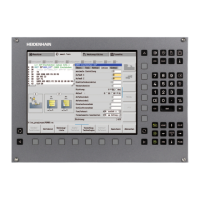55
Error compensation
Overview
The MANUALplus 620 automatically compensates mechanical
errors on the machine.
Linear error
Linear error can be compensated over the entire travel range for
each axis.
Nonlinear error
The MANUALplus 620 can compensate for ball-screw pitch errors
and sag errors simultaneously. The compensation values are
stored in a table.
Backlash
The play between table movement and rotary encoder
movement on direction changes can be compensated in length
measurements by spindle and rotary encoder. This backlash is
outside the controlled system.
Hysteresis
The hysteresis between table movement and motor movement is
also compensated in direct length measurements. In this case the
hysteresis is within the controlled system.
Reversal spikes
In circular movements, reversal spikes can occur at quadrant
transitions due to mechanical influences. The MANUALplus 620
can compensate for these reversal spikes.
Static friction
At very low feed rates, high static friction can cause the slide to
stop and start repeatedly for short periods. This is commonly
known as stick-slip. The MANUALplus 620 can compensate for
this problem condition.
Sliding friction
Sliding friction is compensated by the speed controller of the
MANUALplus 620.
Thermal
expansion
To compensate thermal expansion, the machine’s expansion
behavior must be known.
The temperature can be recorded via thermistors connected to
the analog inputs of the MANUALplus 620. The PLC evaluates the
temperature information and transfers the compensation value to
the NC.
Load Adaptive
Control (LAC)
(option 143)
LAC (option 143) enables you to adapt controller parameters
dynamically depending on the load or friction.
In order to optimize changed control behavior at differing loads,
adaptive feedforward controls can exploit data on acceleration,
holding torque, static friction and friction
Crossover Position
Filter (CPF)
To increase the stability of the position control loop in systems
with resonances, the position signal from the position encoder,
which is filtered through a low-pass filter, is combined with the
position signal from the motor speed encoder, which is filtered
through a high-pass filter. This signal combination is made available
to the position controller as actual position value. The possible
position controller gain (k
V
factor) is increased significantly by this.
The filter separation frequency is set specifically for each axis via
machine parameters. The CPF can be used only in dual-encoder
systems, i.e. on drive motors with speed encoder and position
encoder.

